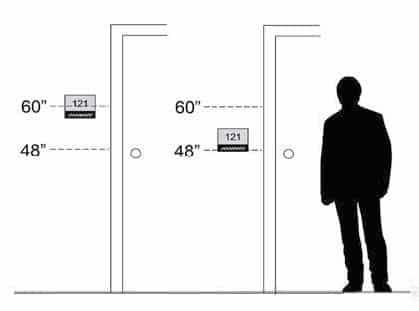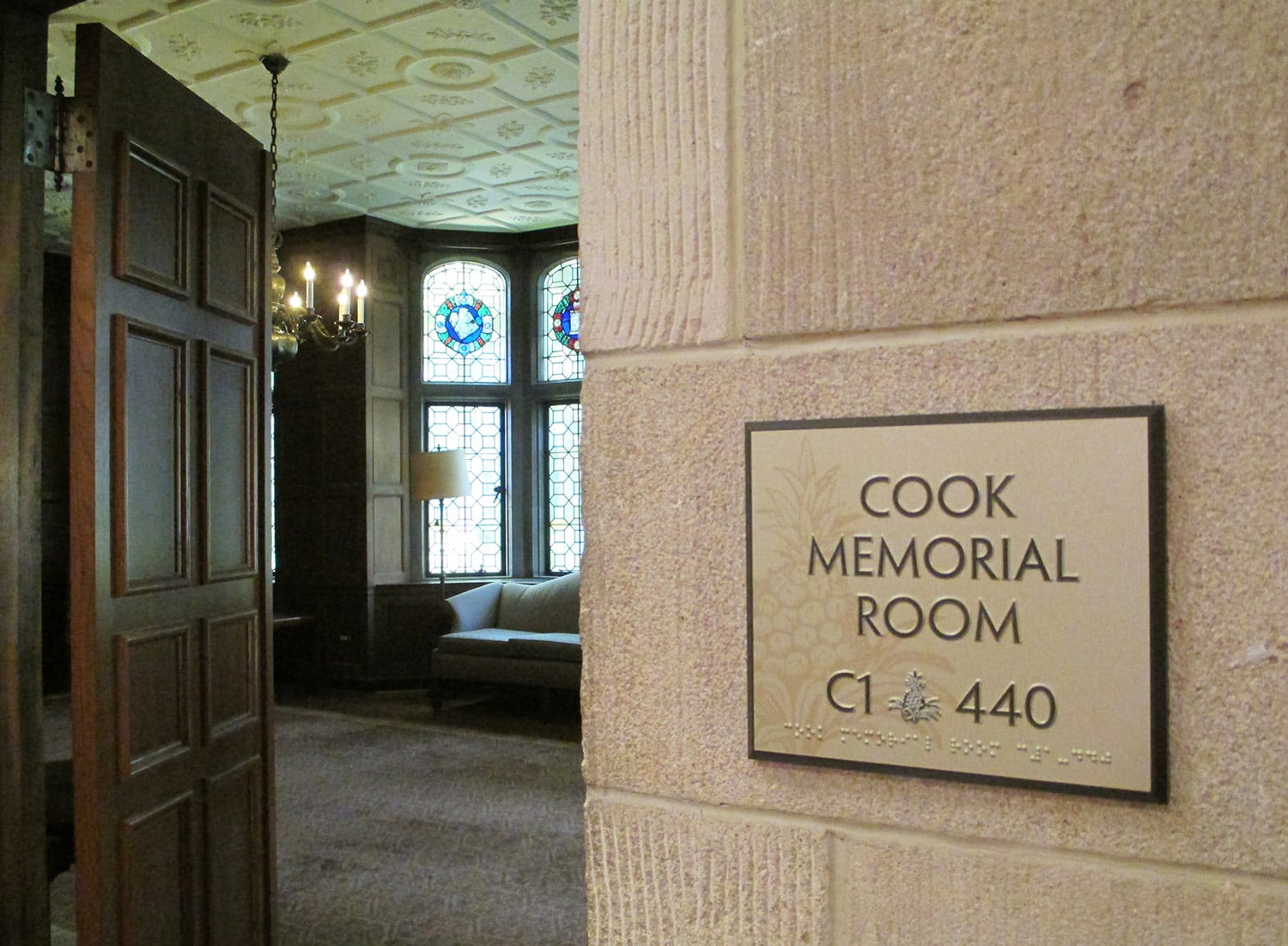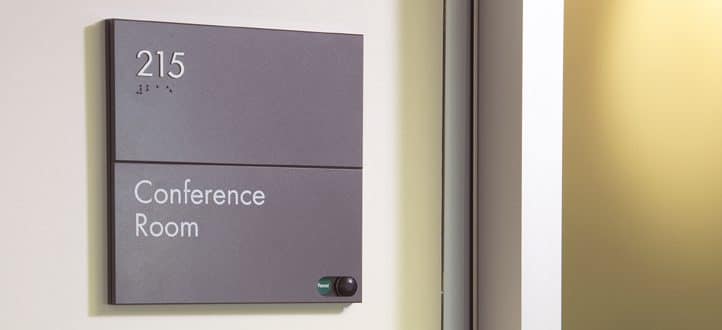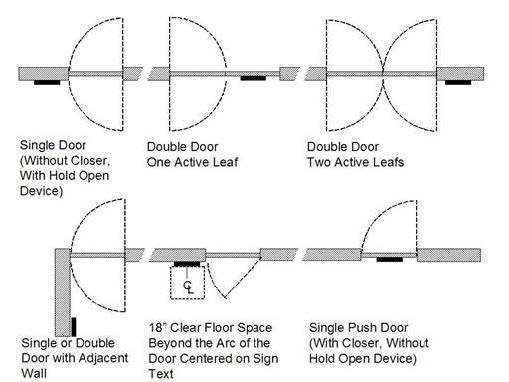How to Achieve ADA Signage Compliance: Mounting Height
The Federal ADA signage guidelines can be difficult to navigate due to their complex and meticulous requirements. Our new series, “How to Achieve ADA Signage Compliance,” aims to empower sign manufacturers with the education they need to ensure ADA compliance for each sign they ship out.
Installing signs in public structures to accommodate a wide spectrum of those with visual impairments is more than a courtesy; it is a federal requirement. Beyond ensuring the design and fabrication of your ADA signage is compliant, manufacturers must also be keenly aware of mounting height and location regulations to avoid damaging lawsuits and penalties. So that you can consistently mount signage in compliance with the ADA, we have put together this guide on how to measure your mounting heights for every room and space.
Mounting Height Specifications

The mounting height of your signage is governed not by the sign itself but instead by the height of the message on the sign (as specified in section 703.4.1). The message height must be mounted a minimum of 48” above the ground surface and a maximum of 60”. This is measured from the baseline of the highest tactile character, giving manufacturers roughly 12-13″ to contain their text. In locations that are primarily used by adults, it is recommended that the top line of text be as close to 60” as possible. Braille should be positioned underneath the entirety of its corresponding text and should be separated by a minimum of ⅜” from any decorative elements or raised borders.
It is important to note that there are exceptions and additional guidelines to the above requirements. The ADA mentions that tactile controls for elevator car controls don’t need to comply with these requirements. For the state of California, Title 24 specifically states that signage should be mounted 60″ above floor level to the center of the sign and should be measured to the bottom of the braille. Signs also cannot protrude more than 3” from the wall and must be edged or rounded with a minimum of ⅛” radius. This contrasts with the national regulations that are based on the range between the bottom and top of raised text and should be regarded above the ADA.
Mounting Location Specifications
The specific location where your sign is mounted to an entryway is just as important as its mounting height. These requirements are tied more to sign panels and doorway environments than the messaging or design. Section 703.4.2 of the ADA standards states that signage should be installed alongside the latch (and handle) side of the door. If there are two active double doors, the sign should always be located to the right of the right-hand door. For double doors with one inactive, the sign should be placed directly on the inactive door. In general, it is discouraged to install a sign on a door that has inadequate wall space. However, the allowance may be granted if the door swings in the push direction, has an automatic closing device, and does not have a “hold-open” device.

Signs including tactile characters should be mounted with a clear floor space of 18 “ by 18” minimum, correlating to about 9″ away from the edge of the door frame to the center of the sign. Though very similar to the ADA compliance guidelines, California Title 24 requires additional considerations when it comes to the location. According to Title 24, signs that have an inadequate space around the doorway are to be installed on the wall adjacent to the latch side of the door. Additionally, Tactile Exit signs must be mounted on the approach side as one leaves the space.
Sign Height & Location Recommendations
The best way to avoid potential issues with signage compliance is to follow consistent mounting practices regardless of the nature of the sign. Take into consideration the positioning of users (such as those in wheelchairs), as well as the needs of blind and visually impaired individuals. Visually impaired individuals won’t necessarily always rely on or even know braille so placing signs as close to perpendicular to their line of sight is encouraged. Additionally, it is best to distinctly separate room numbers from the text on signs and to avoid using vertical text and multiple lines of text.
Even though it is not in violation of the ADA, it is best to avoid mounting signs on doors that swing out, even if they are typically inactive. For the best results, consider the following location recommendations:
- On Restroom doors, mount two signs – one to the right of the latch and one on the door. Sign redundancy supports identification if the restroom is very busy.
- Install signs on both sides of double doors to support wayfinding.
- Overhead, hanging identification should ideally be at least 84″ to avoid bumping people’s heads.
- For low ceilings, avoid the use of overhead signs altogether to avoid potential injury.
Nova Polymers Solution
You should be confident that your sign is tightly mounted and that its location cannot be shifted. Choosing the right adhesives for mounting will ensure that signs do not drop over time as visitors directly interact with them. At Nova Polymers, we count on a wide variety of adhesives that are suited for both interior and exterior applications. To get started, you can take a look at our adhesive selection tool to determine what materials should be considered for your ADA-compliant signage mounting.
Another great way in guaranteeing your constant compliance comes in the form of automated aids, particularly in the design process. Our Workflow Manager Sofware is configured to support ADA compliant spacing, fonts, materials, and all the minute details of ADA compliance that may be easily overlooked.
Key Takeaways
Ultimately, complying with ADA mounting height and location is a matter of attention to detail. Not only will it help you avoid complaints and violations of legislation but it will also enforce the safety of your visitors and build their trust in your facility. If your permanent structure is in California, remember to consider both the ADA signage guidelines and the California Title 24 as part of the California Code of Regulations (CCR).
Nova Polymers is an experienced manufacturer and distributor of photopolymer signs specializing in ADA-compliant production and installation. For more information on mounting compliance and assistance, contact us today.


